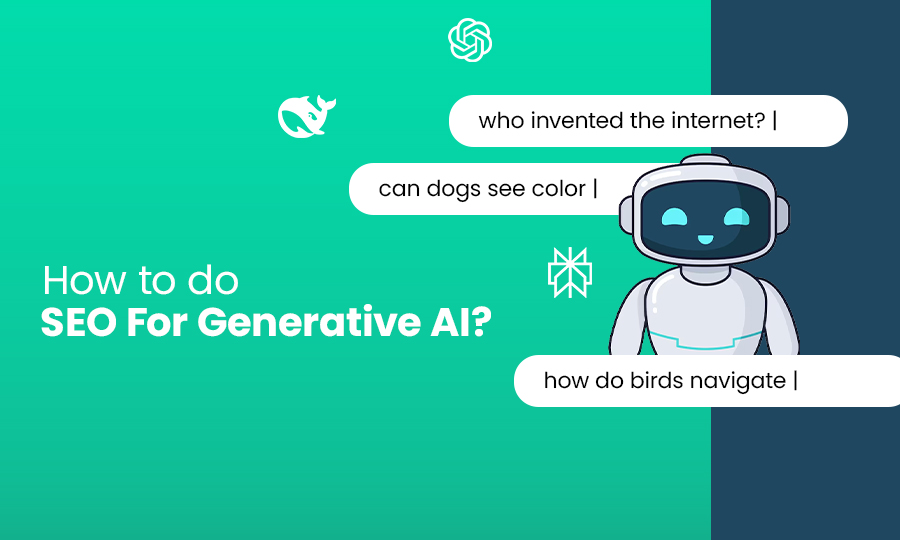Generative artificial intelligence came to the tech industry around the 2010s. It can help you create new images, write, and answer questions directly. But people have to access that generative AI content flawlessly in search engines. Otherwise, the strengths of generative search engines will not be fully recognized. Here comes SEO for generative AI.
SEO stands for Search Engine Optimization. It will help your content to be visible on search engines like Google. 49% of B2B marketers use SEO strategies to enhance their online visibility and for new leads.
However, there has been a paradigm shift in search behavior. The advanced algorithms of AI help people to get answers on AI-powered search engines like Google’s Search Generative Experience (SGE), Microsoft Bing (with ChatGPT), and so on.
AI is helping digital marketing become more prosperous. So the traditional SEO practices can be backdated nowadays. Therefore, content marketers need optimizing content for generative AI. Unlike traditional search engines, generative engine optimization (GEO) specializes in understanding the actual content and fulfilling the user’s need, rather than just higher search rankings.
In this blog, you’ll learn how to do SEO for AI content with both on-page and off-page SEO strategies. We’ll talk about keyword research, writing SEO-friendly content, using the right Meta tags, and how to get quality backlinks. You’ll also see how to adjust generative AI tools to create engaging content for human readers and measure your SEO metrics. We’ll also explain how E-E-A-T (Experience, Expertise, Authoritativeness, and Trust) can give you the best results, even with AI-driven search engines.
Most importantly, you’ll get to know how to improve your search engine rankings for content in generative engines, get more clicks, and improve your SEO practices in the dawn of generative engines.
What is SEO?
SEO is the acronym for Search Engine Optimization. As its name suggests, SEO is the technique for improving your website’s appearance in search engines like Google, Bing, Yahoo, DuckDuckGo, Baidu(Popular in China), and Yandex (most used in Russia).
The importance of SEO strategies
- Attract organic traffic: Traditional SEO practices will attract website traffic without any paid ads, like the Sponsored Content creation process or any other Google Ads (Search Ads) or social media ads.
- Placed at the top of the search results: When someone searches for any specific services or any questions, Google provides a list of results. These are called Search Engine Results Pages (or SERPs). A well-planned SEO will uplift your page to the top of these results.
- 24/7 working: Moreover, your website is operational 24/7. Someone in a different time zone could discover your website and buy from you when you’re not awake. That’s why you need SEO for generative AI to show your content through generative engines and get more people to your site.
Let’s understand through an example: suppose you have a small bookstore named “Page Turner.” You can enhance your SEO by incorporating keywords like “independent bookstore” and “rare books Chicago” into your website. Your daily online visibility will increase from 10 to 100 within three months. Though there are more specifications to get the best SEO results. You’ll get them gradually through this blog.
What is Generative AI?
- Generative = It can generate or create things like text, images, music, or code.
- Artificial Intelligence = These are smart computers that can learn and make decisions like humans.
So, Generative AI such as ChatGPT (text), GitHub Copilot (by GitHub & OpenAI), Adobe Firefly, Jasper AI, Synthesia, DALL·E (images), and MusicLM (music) can create new content based on patterns they’ve learned from data. SEO for generative AI is very important as these innovations transform how people search for and find information online. These AI programs can create websites, write articles, and even respond to user queries.
The importance of generative AI –
- Find information easily: Most people ask AI questions directly and receive accurate responses rather than browsing through Google results.
- Quick content creation: Moreover, in this fast-paced world, companies can develop product descriptions, blog entries, and social media posts within a few seconds.
- Customizes experiences: AI can produce particular content for every visitor according to their preferences and actions.
- Performs repetitive tasks automatically: Content marketers can focus on strategy while AI takes care of writing tasks that need to be improved.
- Makes technology accessible: Most of a non-technical background do not know about code or programming. But AI helps them to make websites and other visuals just by typing prompts.
Suppose you have a small bakery, and you implement generative AI to generate weekly recipe blogs. And you post content three times a week, which has brought 300% more people to your website and more people into your store. Your business has seen substantial growth and success as a result.
Related: How Generative Engine Optimization (GEO) Is Changing the Future of Search?
Why SEO Is Important For Generative AI?
Generative can produce any text, images, and videos. However, that content is useless if nobody can access it. That’s where SEO (Search Engine Optimization) helps. It makes content simple to discover on search engines.
- AI Search Engines transform the nature of search
Unlike traditional search engines, AI search engines like Google’s Search Generative Experience (SGE) can provide precise answers rather than blue links. This is the shift of search trends from searching for information to receiving direct answers. Therefore, you cannot just depend on traditional SEO tactics like keyword stuffing or just building backlinks. Today’s SEO professionals adopt new strategies based on how AI powered search engines understand and rank content.
- Match User Intent, Not Just Keywords
Generative engines try to figure out what the user really means when they type in search queries. That’s why your titles and content have to reflect genuine questions.
If your YouTube video is labeled as “Cool Tricks with AI” but people search for “How to use AI art tools,” Your content might not appear on the search engine results pages (SERPs). Therefore, you should do keyword research and use relevant keywords to rank well. Therefore, you need to make sure that your content addresses the specific queries and concerns of your target audience.
- Natural language processing
Artificial intelligence (AI) uses natural language processing (NLP) to enable computers to comprehend, read, and react to human language. Generative AI tools and AI-driven search engines implement natural language processing (NLP) to understand full questions and answers. Your content should be authentic, reliable, and data-oriented. You have to write in a way that AI algorithms can understand your writing and give it a higher ranking in search results.
- Optimizing Techniques Need to Change
SEO tactics today aren’t just about information. You need to:
- Improve the meta tags
- Pick the right SEO tools.
- Look at how users act and how search trends change
- Change the results for a local search
- For generative engine optimization (GEO), you should change your optimizing content.
These tips will make sure that your site shows up in both natural search results and creative search results.
- SEO Enhances Online Visibility in a Generative World
Moreover, SEO professionals can combine relevant SEO practices with generative AI to get the most organic search traffic.
- Raise your website’s visibility
- Upgrade search rankings
- Develop engaging content for both humans and AI
This will raise digital marketing success in an era of AI-driven search engines.
How to Do Keyword Research for Generative Engines?
Research keywords is very important to implement strong SEO efforts. Without proper keywords, your content can not be ranked, so you can’t skip this process. Let’s explore how you will get your targeted keywords for ranking your website on both traditional search engines and AI-driven search engines.
What is Keyword Research?
The words or phrases that people type into search engines to find something are called keywords. There are specific keywords that you need to know if you want to enhance your website’s ranking. So the process of recognizing the relevant keywords is called keyword research.
Example: If someone searches for “best generative AI tools for students,” that entire sentence is a keyword (also called a search query).
How to Choose the Right Keywords?
Learn about your audience- First, you need to know who your target audience is and what search queries they use.
What Are The Best Tools For Keyword Research?
Here are a few paid and free tools that can help you do that:
- Autocomplete and “People Also Ask” are things to look at on Google Search.
- AnswerThePublic—Look at what people are asking.
- Ubersuggest- You can get topic traffic, complexity, and content ideas.
- Check out Google Trends to see if your term is becoming more famous.
- Semrush, Ahrefs, and Moz are expensive but strong, advanced SEO tools.
Step-By-Step Guide for Keyword Research in the SEMrush Tool
Step 1: Sign Up or Log In
- Go to www.semrush.com
- Create an account (free trial available) or log in to your existing account.
Step 2: Go to the “Keyword Overview” Tool
- On the SEMrush dashboard, look on the left sidebar.
- Click on “Keyword Overview” under the “Keyword Research” section.

Add “AI writing tools” to the search bar, then click on “Search“. Then get the following list-
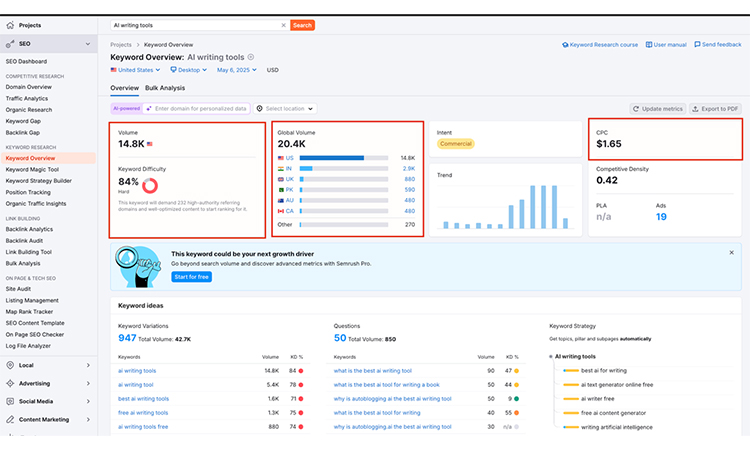
Step 4: Read the Keyword Data
SEMrush gives you a full report. You have to go through these points and then choose your relevant keywords-
- Search Volume- It’s the average number of searches a keyword gets per month.
- High Volume = More people searching = More traffic potential
- Low Volume = Fewer searches, but may be easier to rank for
- Keyword Difficulty (KD): It tells you how hard it is to rank on Google’s first page for a keyword.
- Measured from 0% to 100%
- Higher % = Harder to rank (more competition)
- Trend: Shows if it’s rising or falling in popularity.
- CPC: Cost per click (useful if you want to run ads)
- SERP Analysis: Shows who is ranking for this keyword.
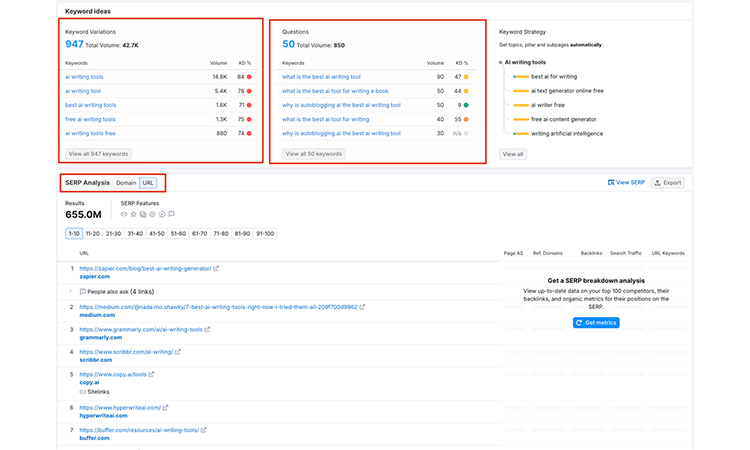
Step 5: Check Keyword Variations & Related Keywords
- Scroll down to see:
- Keyword Variations (ex, “best AI writing tools”)
- Questions (ex, “What is the best AI content writer?”)
- Related Keywords (ex, “AI blog writer,” “AI content creation tools”)
Tips for Keyword Research in the Generative AI Era
- Focus on long-tail keywords: They are more specific and easier to rank.
Example: “How to use ChatGPT for small business marketing” - Use natural language: AI engines love fluency optimization. Use full, real-sounding questions and answers.
- Look at questions, not just phrases: Tools like AlsoAsked and AnswerThePublic help you find what real people ask.
- Group keywords into clusters: You can develop one strong blog or page for a keyword group. Example:
- Main: “AI content tools”
- Related: “best AI writing tools”, “ChatGPT for content”, “how AI writes blog posts”
Now you have all the details on how to choose keywords. Try to incorporate questions on your blog to get listed in AI-driven search engines.
On-Page SEO for Generative AI
Have you ever thought of how you will show your website on ChatGPT or Google Gemini? When someone asks questions about those generative engines. That’s what on-page SEO for generative AI is all about! You need to develop content for both traditional search engines and new generative search engines. You have to develop on-page SEO in a way that AI-driven search engines can recommend your website on their search results.
Why On-Page SEO is Important for Generative AI?
Imagine you have two doors to your website:
- The traditional search door (Google search results)
- The AI conversation door (when AI tools recommend your content)
You’re losing out on half of your prospective guests if you simply optimize for the first door! If AI suggests your web pages in generative search results, then you can get organic search traffic.
Top 5 On-Page SEO Optimization Strategies for Generative Engines
The following are the best approaches you need to implement for better user interaction-
- Target audience & content quality
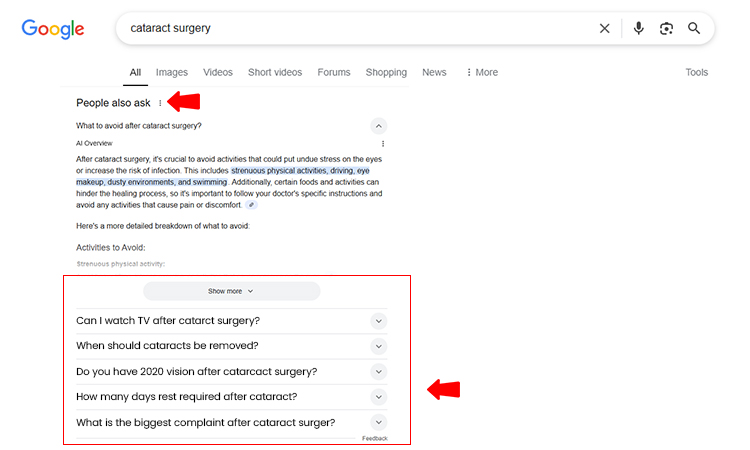
First, you have to understand about your target audience and what their requirements are. If you select a topic to write, you can simply Google search or use tools like AnswerThePublic, AlsoAsked, and Google Trends. You can get a clear knowledge of what people search, so you can incorporate those into your content.
AI search engines prefer content that fully covers all users’ queries. Modern AI uses natural language processing (NLP) to recognize content like humans do. It acknowledges when content specifically answers questions people frequently ask. When you write for humans, your content needs to be chosen by generative AI so that generative search engines can find your website.
Practical steps:
- Find out what people are asking about your subject.
- You need to answer these questions in a precise way.
- Give background knowledge, cases, and context.
- Talk about complicated issues from different points of view.
- Add new information to the website daily.
- Avoid keyword stuffing or unnatural phrasing
- Use conversational headers that match natural questions
- Include phrases people actually use when asking about your topic
Example- If you’re writing a brief article about the “Best Headphones 2025,” write a thorough guide that describes headphone technology, contrasts various models across price points, reviews features, and gives case studies, also offering specific recommendations.
- Comprehensive E-E-A-T guidance
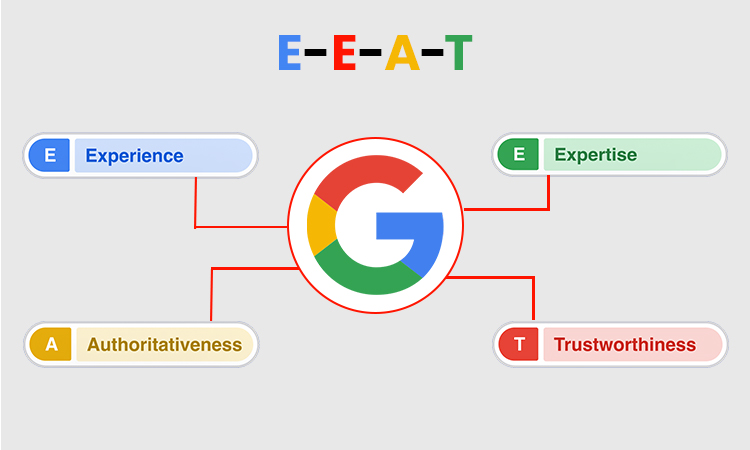
E-E-A-T signifies Experience, Expertise, Authoritativeness, and Trustworthiness. Google and other search engine algorithms use these signals to decide a content’s ranking. In SEO content creation, Google picks content that displays real knowledge and value. That’s why optimization strategies must focus on creating helpful, reliable content, not just stuffing keywords.
What Each Part Means:
- Experience: Have you used or tried the thing you’re writing about? Something like a real review of an AI use.
- Expertise: How well do you know your subject? This shows that the information is correct and well-researched.
- Authoritativeness: Are you or your website established as a verified source in that area?
- Trustworthiness: Is your content trustworthy, secure, and fact-verified?
Example: Suppose a content writer writes a blog “SEO for Generative AI” with AI-generated tools, which will rank higher than one that is plagiarized from other sources.
- Headings are essential
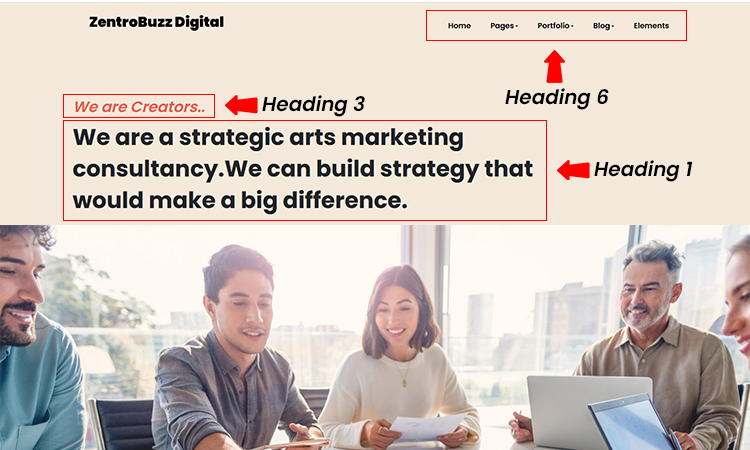
Headings are the names of the specific segments of your blog or article. They help readers and search engines recognize your content.
How to Write Good SEO Headings:
- Include Keywords
Add the main keyword (like “SEO for Generative AI”) in at least one heading. - Use H1, H2, and H3 Tags Properly
○ H1 = Main Title (used only once)
○ H2 = Main Sections
○ H3 = Subsections under H2 - Make Them Clear
Explain the topic of the section.
Example: “Why SEO is Important for AI” is better than “Important Stuff.” - Be Short and Catchy
Always try to incorporate short and simple terms that resonate with all kinds of people.
- Meta Titles & Descriptions
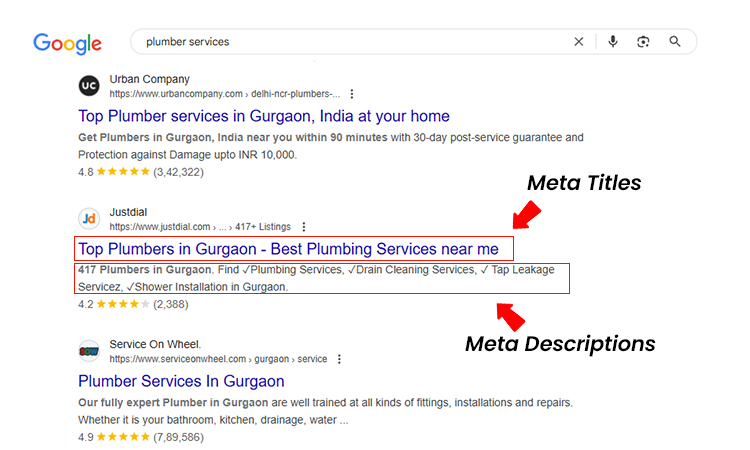
Meta titles and Meta descriptions are short segments of text that show up on SERPs. They tell users and search engine algorithms what your page is about.
- Meta Title = The headline shown on Google (clickable link)
- Meta Description = The short summary below the title
They don’t appear on your webpage, but they are super important for SEO content creation and optimization strategies.
How to Write a Good Meta Title:
- First, you have to put the main keywords at the start of phrases.
- Try to keep within 55-60 characters
- It has to be simple and easy to digest by everyone
- Every page should have a unique title
Example:
“SEO for Generative AI: Boost Visibility with Smart Tools”
How to Write a Good Meta Description:
- Add your main keyword naturally
- Keep it under 160 characters, otherwise it can be cut off.
- Explain the page’s value (what users will learn)
- Add a call to action like “Learn how” or “Get tips.”
Example:
Learn top SEO strategies for Generative AI. Boost your rankings with smart tools and expert tips!
Advanced Tip: Strong Meta titles & descriptions increase click-through rates (CTR) and help AI search engines understand your content better.
- Include engaging media
One of the important parts is visualization for your website. You have to use perfect visuals for user participation. You need to optimize images to improve page speed, increase SEO rankings, and make your content easier for generative engines to understand.
How to Optimize Pictures for On-Page SEO:
- Use Descriptive File Names
- You can change your image name with relevant keywords.
- Example: Instead of IMG001.jpg, use generative-ai-tools.jpg.
- Add Alt Text (Alternative Text)
- Search engines and screen readers will use this to describe your picture.
- Use terms organically.
- Example: Alt =”Graph showing SEO growth using generative AI toolkit”
- Compress Image Size

- You should compress your picture size to improve website loading speed and performance. So that you can use TinyPNG or Squoosh to make your images smaller without losing quality.
- Helps pages load faster (Google loves fast websites!).
- Use the Right Format- Moreover, you have to use WebP or JPEG for photos, PNG for graphics, and SVG for icons/logos.
- Responsive Images- You can resize your image for mobile, tablet, and desktop. So that any user can see your visuals easily. Moreover, you website also responsive for any devices.
- Use Captions When Needed- If you think the picture needs more information, add a caption below it to get people more interested.
- Technical Markup and Schema
Technical markup is the use of additional code (also known as schema or structured data) on your website to improve search engine comprehension of your content.
Schema is written in NLP (JSON-LD), and it tells search engines more about your website, like who wrote it, what it’s about, reviews, prices, videos, and more.
Why is schema important for generative AI?
Generative AI toolkits like large language models (e.g., Google SGE, ChatGPT) analyze web content to answer user queries. Schema will help these systems to –
- Recognize your content easily
- Match your website page to user intent.
- Show your content in special boxes like rich results or featured snippets.
This improves your search engine exposure and fluency optimization (how smoothly content is understood by both users and AI).
Best Types of Schema for SEO (especially for AI):
- Article—for blog posts or news
- FAQ – Helps your questions show in Google’s “People also ask.”
- How-To—Shows step-by-step instructions
- Product—Great for eCommerce websites
- Video— Improves online appearance if you embed videos
- Organization/Person—Tells who is behind the content (great for E-E-A-T)
Google may show your questions and answers right on the search page if you add the FAQ schema to your blog post. This will get more people to click on your link.
- Regularly update content
If you stay relevant to users, you can occupy a higher ranking in search results. You need to analyze user behavior to provide the desired copy that they want. As generative engines always focus on user intent, your content should be focused on that.
Moreover, you need to update content frequently to stay relevant in search queries. You have to follow the search landscape very well to get new trends. So, overall, you have to keep a keen eye on the searching patterns of your users. That’s how you can produce content that can be chosen by AI-driven search engines.
Off-Page SEO in the Generative AI Era
Off-page SEO is one of the most integral parts of generative AI engine optimization’s success. Even though generative AI algorithms put a lot of emphasis on the quality of the content, they still use a lot of traditional signals to figure out who is authoritative and trustworthy.
Why Off-Page SEO Is Important for the AI space?
- Authority signals: Generative engine optimization (GEO) is a statement of authority. It always chooses relevant sources with strong backlink profiles when providing answers. If you want generative engines to link to your website, it must have high-quality backlinks.
- Trust indicators: Citations and external mentions help AI algorithms to optimizing content for the valid sources.
- Brand recognition: There is a higher chance that a brand will show up in AI-generated responses when it is mentioned a lot on the web.
- Content amplification: Social shares and user engagement data help your content connect with more people, and it will help in generative engine optimization.
- Expert validation: When industry experts link to or mention your content, it signals to AI-driven search engines that your information is trustworthy.
Top 4 Most Useful Off-Page SEO Strategies for Generative AI
Suppose a fitness website with comprehensive content on workout techniques wasn’t appearing in AI responses until they built backlinks from health publications and fitness influencers. After improving their off-page signals, AI tools began citing their exercises and suggestions regularly.
- Develop high-quality backlinks
Link building refers to getting links from other websites. When you put links from other websites, it proves your authenticity and solidity. It gives you more traffic to your site. You need to build quality links for your website to be visible in generative engines.
How to Build Quality Backlinks?
- Write Great Content That Others Want to Share- First, you have to createhelpful blogs, guides, or videos. Your write-ups should be informative, user engagement data-oriented.
Example: A blog called “Top 10 Free Generative AI technologies for Beginners” is likely to get shared and linked by other AI websites.
- Guest Post on Other Websites
When you write an article or blog post for someone else’s website rather than your own, it’s called a guest post. Guest posting is a very important strategy for digital marketing.
Let’s say you have a blog about generative AI innovations. You could write a guest post for a tech site titled “5 Ways Students Can Use Generative AI to Study Smarter.”
At the end of your post, you might include a short author bio like:
“This article was written by [Your Name], who blogs at [YourWebsite.com]. Check out their guide on AI-powered writing tools.”
That link in your bio is a backlink, which helps with your search engine visibility.
- Use HARO (Help a Reporter Out)
Then, the most important approach to getting backlinks is mentioned by big journalists. You can write specific content for journalists, and then they can mention your site on any other relevant websites.
- Share Your Work on Social Media & Forums
Moreover, you can share your work on social media and forums like LinkedIn groups, Reddit, Quora, or AI communities. This will be a great way of getting backlinks.
- Fix Broken Links
In this process, one more thing you have to keep in mind is that you should regularly check for broken links on your website and fix them. You have to take care of this for a good user experience.
Tip for Beginners:
Always try to link building from sites that are useful and trustworthy, not fake ones. It’s better to have one link from a good site than 100 links from bad pages.
- Brand Mentions are important
The reputable brands can mention your website in their sources. So it will help AI search engines to list your site. Moreover, you can get mentioned in forums, podcasts, or interviews related to your niche. It will increase your integrity, as many of the famous brands mention you.
- Be Active on Social Media
Over 90% of businesses use social media marketing to get new clients or reach. Nowadays, social media reaches you at every doorstep. When your brand is circulating through social media, it will automatically bring the attention of AI search engines. Though social media is not a direct part of traditional SEO practices, it will bring attention to your target audiences. You have to update content frequently on social media; otherwise, you lose the opportunity to engage with your audience and stay relevant in their feeds. Moreover, social media enhances direct interaction with your customers. So that you can have instructive feedback and create unbreakable relationships with your clients. In this way, your brand stands out in generative engine optimization (GEO).
- Influencer & Creator Collaborations
Then, the most special strategy is to collaborate with influencers. According to multiple marketing reports (like those from Statista and Influencer Marketing Hub), a large percentage of U.S. marketers—around 69% or more—working in companies with 100+ employees do use influencers as part of their marketing campaigns. In this strategy, you can collaborate with adequate influencers to review or promote your content or product. These will increase legitimacy, so it will help in generative engine optimization (GEO).
Technical SEO Considerations for Generative AI
Technical SEO is important because it helps search engines and AI systems find, understand, and show your website to people. Think of it like making sure your house has a clear address, open doors, and organized rooms so visitors can easily find what they need. Without good technical SEO, your website might have invisible barriers that keep search engines from seeing your content, no matter how good it is. This means fewer visitors, less business, and wasted effort on content that nobody discovers.
Most Useful Strategies for Technical SEO
You have to maintain these tactics to appear in generative engine optimization-
- Maintain Website Navigation and Indexing
AI-driven search engines still browse your site with regular bots, but now they examine website structure more closely to get more information. So you have to maintain the following techniques-
- XML sitemap- An XML sitemap is a unique file that makes a list of all your website’s important pages. This instructs search engines what pages are there and how to get to them. It will help to index your site on Google.
Tool: You can create one using tools like Yoast SEO (for WordPress) or XML-Sitemaps.com. - Robots.txt– Search engine bots can read a robots.txt file to find out which pages on your site they can and cannot crawl. Moreover, bots are prevented from crawling irrelevant or duplicate pages (such as admin areas).
Tool: You can test it using Google’s robots.txt tester. - Canonical Tags- Search engines can determine which version of a page is the primary one by using a canonical tag (<link rel=”canonical” href=”URL” />), particularly when there are several similar pages. It will help you avoid redundant content issues.
Tool: Use Screaming Frog or Ahrefs Site Audit to check canonical tags.
- Optimize Website Speed and Core Web Vitals
A recent study found that 53% abandon websites that take more than 3 seconds to load. So you have to maintain your speed in a very professional manner. You need to take good hosting in terms of page speed. The fast-loading, smoother website ranks well in both traditional search engines and AI-powered generative engines like Google’s Search Generative Experience (SGE)
How to do it:
- Use compressed-sized pictures, but do not compromise on resolution.
- Then you can incorporate a content delivery network (CDN) and allow browsers to cache.
- Pay attention to the numbers for Largest Contentful Paint (LCP), First Input Delay (FID), and Cumulative Layout Shift (CLS).
Extra Tip-
- Largest Contentful Paint (LCP)—LCP measures how long it takes your web page’s largest visible graphic or text block to load and appear.
Why it matters: Even if other parts of your site load faster, people will think this part loads slowly.
Good score: below 2.5 seconds - First Input Delay (FID)- FID measures the time it takes for your site to respond after a user clicks on a button or link or interacts with it for the first time.
Why it matters: A slow response makes your website feel laggy or broken.
Good score: Less than 100 milliseconds
Note: Google is replacing FID with a newer metric called INP (Interaction to Next Paint) in 2024, which gives a better picture of how quickly your site reacts overall. - Cumulative Layout Shift (CLS)- CLS calculates how much the content moves during loading, such as when buttons or text abruptly shift.
Why it’s important: Users get annoyed when data is moved around, and they click on things by mistake.
Very good: Less than 0.1
Why are these important for SEO strategies? - These are ranking factors in Google’s algorithm.
- Better scores = better search engine visibility.
- AI may like smoother sites for featured answers, so this is also important for generative engine optimization.
- Secure Your Website with HTTPS
HyperText Transfer Protocol Secure is what HTTPS stands for. It’s the safest version of HTTP, which is how your computer connects to websites. Generative engine optimization need secure website to rank higher.
How to do it:
- Install an SSL certificate– SSL is an acronym for Secure Sockets Layer. It’s a one kind of digital certificate that encrypts the data between your website and your visitor’s browser. So that hackers can’t steal personal information like passwords or credit card numbers.
- Redirect all HTTP traffic to HTTPS.
Tools: You can implement free tools like Let’s Encrypt for a free SSL certificate.
- Many hosting services (like Bluehost, GoDaddy, or SiteGround) offer one-click HTTPS setup.
Local SEO for Generative AI
Local SEO + generative AI = more people near you find and trust your business.
Local SEO emphasizes local searches. When you search for “best pizza shop near me,” some websites appear. Those are local SEO-integrated sites.
Generative AI and AI algorithms now influence how these local searches work. AI algorithms consider user intent, local search results, and fluency optimization instead of traditional SEO, which ranks websites by links and keywords. It will recognize the best match for your search intent, not just matching the keywords.
How Will You do Local SEO?
- First, you can create a Google Business Profile for your company to rank highly in search results.
- Then, make sure you use the same name, address, and phone number (NAP) on all websites. Furthermore, you have to compose local searches such as “New York’s best cupcakes.” Embrace the regional buzzwords to get more exposure.
- Moreover, you can ask for feedback from your satisfied clients. AI driven search engines like the reviews and place your website at the first of the generative engines.
Tools to measure- You can use an SEO toolkit like Moz, Semrush, or UberSuggest to analyze data of local searches.
Content Marketing for Generative AI
Content marketing is one of the most influential strategies of digital marketing. This focuses on creating relevant content that goes with user behavior and their intent. Content marketing is all about developing new, educational, and interesting content. -like blogs, videos, or social media posts—to grab and motivate your audience. Generative AI makes content marketing faster and smarter.
How Generative AI Helps?
Generative AI technologieslike ChatGPT, Jasper AI, or Copy.ai can write blog posts, captions for social media, product descriptions, and more. This helps you post more often and saves time. AI algorithms are also used in these tools to look at trends and figure out what kind of content people want.
Content Strategy Tips
- Create useful material that answers real-world issues.
- Use artificial intelligence to study user behavior and search patterns.
- Refresh old material using AI technologies.
- Optimize your content for voice search and natural language processing.
Future of SEO for Generative Engine Optimization (GEO)
AI search tools are changing the SEO landscape. Nowadays, users ask questions of ChatGPT and other AI assistants and receive direct responses, rather than just searching on Google.
These AI responses require Generative Engine Optimization (GEO) for websites to emerge.
This means
- Direct and precise answers for specific questions.
- Executing simple, conversational language.
- Add facts or statistics that resonate with AI.
- Enable AI to read website code flawlessly.
- Acknowledging your skills increases your authenticity.
There may be times in the future when your website can connect straight to AI systems. More people will visit websites that help AI provide concise answers.
The best way to use digital marketing is to make useful content that people and computers can understand. Companies that can change with the times will do better than those that stick to traditional SEO practices.
Remember: AI wants to give people the best answers, so focus on being the best answer!
Monitor, Iterate, and Stay Updated
- Track SEO Performance Regularly- First, you have tokeep an eye on your website’s traffic, search results, and user actions with SEO tools like Google Search Console, Ahrefs, or Semrush. You have to analyse which pages rank well and which need improvement.
- Analyze Generative Search Trends- Moreover, you cansee how your information shows up in search algorithms that use AI and in innovative search results. It’s possible to see what people are asking and how AI might be answering them with tools like AlsoAsked, AnswerThePublic, and Google Trends.
- Try out Different Optimization Strategies- You could use different keywords, forms (like text, video, or images), or speed up the page load time. Check out what gets people to interact with your site and ranks well in search engines, especially when it comes to generative engine optimization.
- Stay Updated with Algorithm Changes- There are a lot of changes happening in search engine algorithms, especially those that power AI-based search engines. You should read well-known SEO blogs like Moz, Search Engine Journal, or Google’s own blog to keep your strategy up to date.
- Repeat the Cycle- Though SEO is a lengthy process, it ensures you the best results. So, keep growing, update your knowledge, discover, and get reform. Your content will do better in both standard search and AI search the more times you update it.
Let’s Wrap up
So, in the end, you have all the detailed ideas of how do you implement SEO for generative AI. You can write high-quality content, but without SEO, you cannot show off your site on various platforms. In this new generation, digital marketing approaches need generative engine optimization to improve their exposure and online appearances. So what are you waiting for? Start applying these techniques to be recognized by generative engines.
Additional Resources:
- What Is the Difference Between SEO And GEO Marketing?
- The Top SEO Trends to Watch in 2023 and Beyond
- How to do SEO For ‘Near Me’ Searches (SEO Tips That Really Work)

